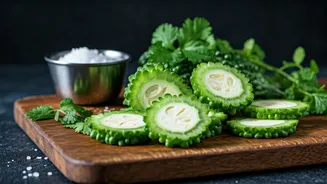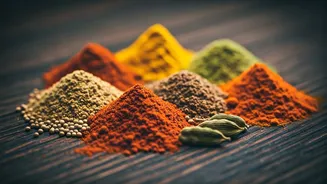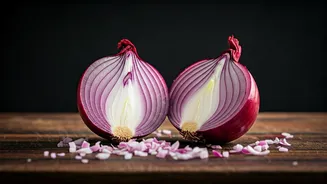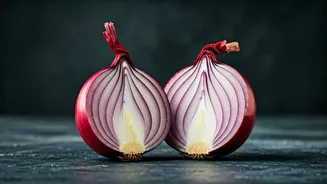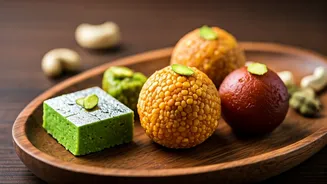Prepping Bitter Gourd
The initial preparation significantly impacts bitter gourd's taste. The first crucial step is proper selection; choose firm, vibrant green gourds. Softer,
yellowing ones tend to be more bitter. Once selected, thoroughly wash and trim the ends. Some cooks suggest scoring the gourd and removing the seeds, as these can contribute to the bitterness. Then, the most vital aspect is salting. Generously salt the chopped or sliced bitter gourd and let it sit for at least 30 minutes, or even up to an hour. The salt draws out the excess moisture and, along with it, a significant portion of the bitter compounds. After salting, rinse the gourd thoroughly under cold water to remove the salt and the bitter flavors it has extracted. This foundational step is the key to unlocking a less bitter and more palatable experience.
Salting and Soaking Method
Following the initial prep, salting and soaking is a robust technique to mellow the bitterness. After salting and rinsing the chopped karela as described in the previous section, consider soaking it in a solution. A simple solution involves soaking the salted bitter gourd in water along with a dash of salt. A more effective solution is adding buttermilk or yogurt to the water. The acidic nature of these ingredients helps further neutralize the bitterness. The key is to ensure the gourd is fully submerged. Let this solution sit for a minimum of 30 minutes, and ideally up to an hour. The lactic acid in the buttermilk or yogurt interacts with the bitter compounds, mellowing them. Similar to the salting step, a final thorough rinsing is necessary to eliminate the remaining salt and any lingering bitterness. This technique amplifies the results of the initial salting and prepares the bitter gourd for a much more pleasant culinary adventure.
Blanching Before Cooking
Blanching is a rapid cooking technique that helps eliminate bitterness. Blanching, a quick dip in boiling water followed by an ice bath, is a swift yet effective method. Before blanching, prepare the bitter gourd as detailed in the initial prep and salting sections. Once the gourd is ready, bring a pot of water to a rolling boil. Add the prepared bitter gourd and allow it to cook for a brief period, usually about 2-3 minutes. Overcooking may make the gourd soft and less firm. Immediately after blanching, transfer the bitter gourd to an ice bath. This process stops the cooking and preserves the vibrant green color and texture of the gourd. The boiling water extracts some of the bitter compounds, while the ice bath ensures the gourd remains crisp-tender. This technique works well before stir-frying or other cooking methods, contributing to a less bitter and more appealing dish.
Using Sour Ingredients
The principle behind this strategy involves counteracting the bitterness with contrasting flavors. Ingredients such as tamarind, lemon juice, or vinegar are the primary components here. The tanginess of these additions masks and balances the bitterness of the karela. In many Indian recipes, tamarind pulp is often employed to add a sweet-sour flavor profile, which works brilliantly with bitter gourd. Lemon juice or vinegar can be incorporated into marinades or added during the cooking process. When adding these ingredients, begin with a small amount and adjust according to taste, as the sourness can sometimes overpower other flavors. This technique is especially useful in curries and stir-fries, where the sour elements can easily blend with the other ingredients, creating a balanced and harmonious dish.
Sweetening the Deal
Another effective strategy for reducing bitterness is introducing sweetness to the recipe. This strategy complements the bitter flavor with a contrasting element. Adding a touch of sugar, jaggery, or even honey can significantly improve the taste of bitter gourd. This principle works because the sweetness can help to mask the bitter notes. The addition of a sweetener is done during the cooking process, allowing it to meld with the bitter gourd. In the case of stir-fries, a pinch of sugar can be added in the final stages of cooking to balance the flavors. For curries, jaggery can contribute a subtle sweetness and a distinct flavor profile. The appropriate amount of sweetener depends on personal preference and the intensity of the bitterness, so begin with a small amount and adjust as needed.
Pairing with Spices
Choosing the right spices is vital to enhance the flavor of bitter gourd. Spices such as cumin, coriander, turmeric, and asafoetida can not only add depth but also help mitigate bitterness. These spices offer warm, earthy undertones that balance the harsh taste. Cumin and coriander add a fragrant complexity, turmeric brings a mild bitterness and vibrant color, and asafoetida contributes a pungent aroma that can help balance the bitterness. Use these spices generously but judiciously. In many Indian recipes, a combination of these spices is often used in the initial tempering stage before the bitter gourd is added. The spices should be sautéed in oil or ghee to release their flavors before the bitter gourd is incorporated, allowing the spices to infuse into the dish. The aromatic intensity of the spices can often mask some of the bitterness, resulting in a more palatable dish.
The Right Cooking Methods
The cooking method significantly impacts the final taste of bitter gourd. Choosing the appropriate technique is essential for achieving the most desirable taste and texture. Deep frying, stir-frying, and roasting are popular choices that can reduce bitterness. Deep frying is effective because it quickly cooks the gourd, creating a crispy exterior while softening the bitterness. Stir-frying, when done correctly, allows the bitter gourd to cook rapidly and evenly, with the addition of spices and other ingredients to improve the flavor. Roasting in the oven can also mellow the bitterness, creating a tender texture with a slightly caramelized flavor. Always ensure the bitter gourd is prepared appropriately prior to these cooking methods. The right preparation and cooking method can make a significant difference, transforming the bitter gourd into a delightful and satisfying dish.
